Sleep apnea is a breathing-related sleep disorder that affects between 5% and 10% of people worldwide. While the symptoms can range from mild to severe, the bottom line is: people with sleep apnea need to find solutions to help them get the best sleep they can. A Continuous Positive Airway Pressure (CPAP) machine is usually the first recommendation for many with sleep apnea.
However, there’s another, more cost effective option that often involves changing back sleepers into side sleepers. Positional therapy for sleep apnea is one way for people with sleep apnea to get better sleep.
I would like to point out that I’m not a medical professional. I am a certified Sleep Science Coach, which helped me give informed insight into this topic. If you think you have, or do have sleep apnea, please consult a medical professional.
How Sleep Apnea Affects Sleep
The most common type of sleep apnea is obstructive sleep apnea (OSA). People who have OSA fall asleep and experience their airways collapsing while they sleep. This can start as snoring, but often OSA causes people to stop breathing for periods of time. When this happens, people will wake up to start breathing again.
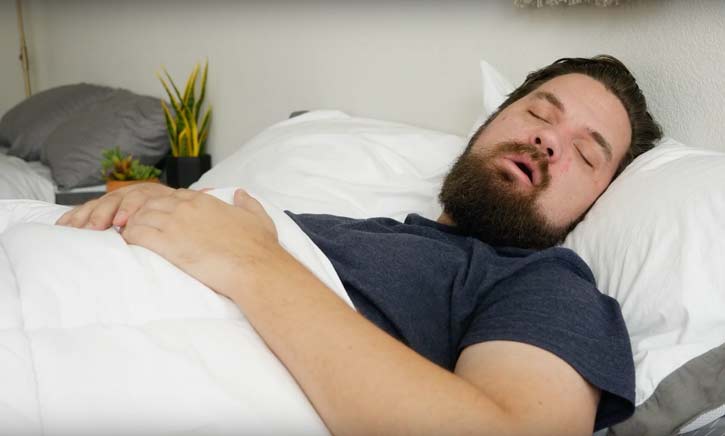
And because this happens so frequently during the night, the quality of sleep you get with OSA is very poor, and you’ll often wake up feeling like you didn’t get any sleep at all. There are other forms of sleep apnea, such as Central Sleep Apnea (CSA) and Complex Sleep Apnea Syndrome (CSAS), but positional therapy is most effective as a treatment, and has been studied for OSA, next to a CPAP of course.
This is just a brief overview of what OSA is and how it affects sleep. For a more detailed article on sleep apnea, be sure to read our what is sleep apnea article.
Best Sleeping Positions for Sleep Apnea
When it comes to sleep apnea and positional therapy, there is actually one sleeping position that is best: side sleeping. While back sleeping is considered the “healthiest” position, the official CPAP website notes back sleeping is considered the “worst” position for OSA.
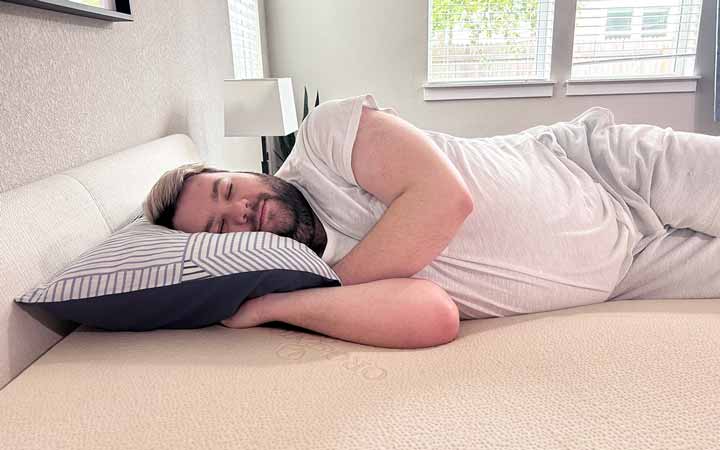
And the answer as to why is as simple as gravity. Because OSA is the collapse of your airways while you sleep, gravity will have the most influence on your airways while sleeping on your back. Side sleeping takes a good amount of pressure off of your airways, and the slight elevation of your torso you get while side sleeping can also be beneficial, as it helps open up the ribcage.
RELATED: Best Sleeping Positions
What Is Positional Therapy for Sleep Apnea?
Positional therapy, as defined by a study published by the National Library of Medicine, is an intervention practice that keeps people on their side during sleep.
Sometimes a doctor will recommend positional therapy for a few different reasons. The first being if you tried the CPAP machine, but no matter how hard you’ve tried, it just doesn’t stick. The second reason is it’s a considerably more affordable option. People with mild to moderate OSA see the most success with positional therapy, so purchasing an expensive CPAP machine wouldn’t be necessary.
Some methods of positional therapy include:
- Using tennis balls in your bed (placed where you’d roll onto your back)
- Sleeping with some sort of sack or backpack
- Using a body pillow (like the MedCline)
- Alarms that vibrate when you sleep on your back
I’ll explain how these help in more detail below.
Positional Therapy vs Positive Airway Pressure Therapy
Continuous Positive Airway Pressure (CPAP) therapy is often the number one recommendation and solution for helping those with OSA. And when comparing it to positional therapy, using a CPAP has been proven to be more effective than positional therapy for people with more severe cases of OSA.
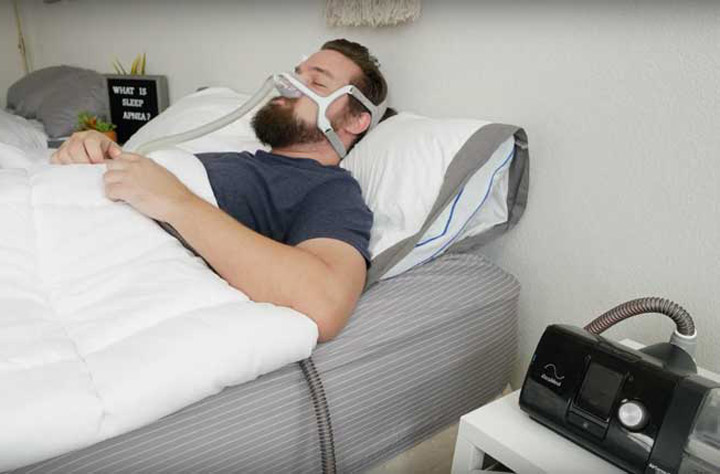
The main difference here is that positional therapy only deals with the sleeping position you’re in while you sleep and doesn’t use a machine. CPAP machines offer a continuous effort to keep your airways open, no matter the sleeping position one is in. With airways open, people with OSA who use CPAP machines are all but guaranteed to see improvement with sleep. Granted, that is if you are able to sleep with your CPAP machine.
How Does Positional Sleep Therapy Work?
I’ve touched on this above, but positional therapy works by simply having someone with OSA adapt to being a side sleeper. As OSA can be more influenced by gravity while back sleeping, side sleeping helps take some pressure off of the airways.
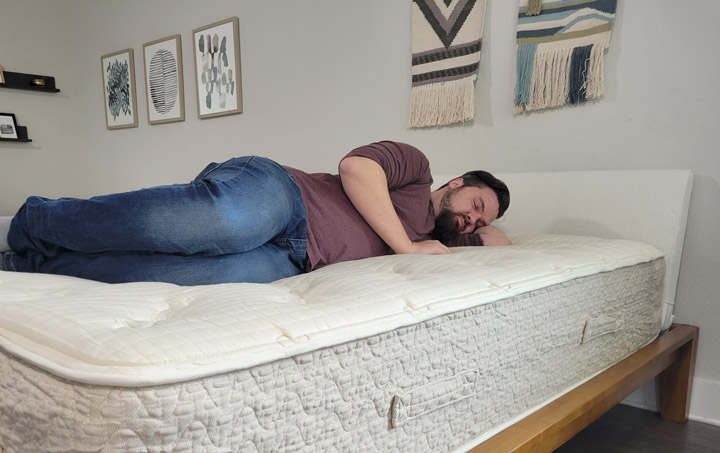
It can be a process to train yourself to be a side sleeper, especially if you were a back sleeper before being diagnosed with OSA. But just the simple act of sleeping on your side takes off strain and lessens the amount of gravity acting on your airways.
Who Is Positional Therapy Beneficial for?
I should point out that I am not a medical professional. Though I am a Certified Sleep Science Coach, OSA is a very serious condition.. You should consult your doctor for the best course of action for your OSA or other type of sleep apnea.
However, a study published in the Journal of Clinical Sleep Medicine shows that those with mild to moderate OSA can benefit from positional therapy. The people who took part in the study trained themselves to sleep on their sides, and that alone was enough to improve their sleep and OSA symptoms for some, though not everyone.
Best Sleep Apnea Positional Therapy Devices
Just like it’s possible to train yourself to sleep on your back, there are a few methods that are recommended to help you sleep on your side, which often don’t need a prescription or a fancy device. And truthfully, the devices you need to practice positional therapy are very simple. It becomes more about training yourself into a certain behavior.
- Tennis Balls: Placing tennis balls in bed or attaching them to your shirt can cause discomfort if you try to move to your back. Because of this, you’ll move back to your side.
- Body pillows: We’ve reviewed many body pillows here at Mattress Clarity, and there are some that are able to run along your back. Just like the tennis balls, the pillow will keep you in place and prevent you from moving to your back.
- Sacks or backpacks: Though a bit more impractical, filling a sack or a backpack up with items to make it sturdy enough to make sleeping on your back uncomfortable is also an option.
- Vibrational alarms: There are some devices that, when it detects that you are on your back, will cause a vibration throughout your bed. Some devices will increase in intensity the longer you remain on your back. When you move back to your side, the device stops vibrating.
All in all, there’s a method that should work for just about anyone to help train themselves to sleep on their side if they have OSA. While CPAP machines are the most effective at handling OSA, if the symptoms are mild enough, changing to side sleeping could be enough of a solution to OSA.
Alternative Sleep Apnea Solutions
While not considered part of positional therapy, there have been studies that prove elevating your head and torso can help with OSA as well. Just like positional therapy, it has to do with easing the influence of gravity on your airways.
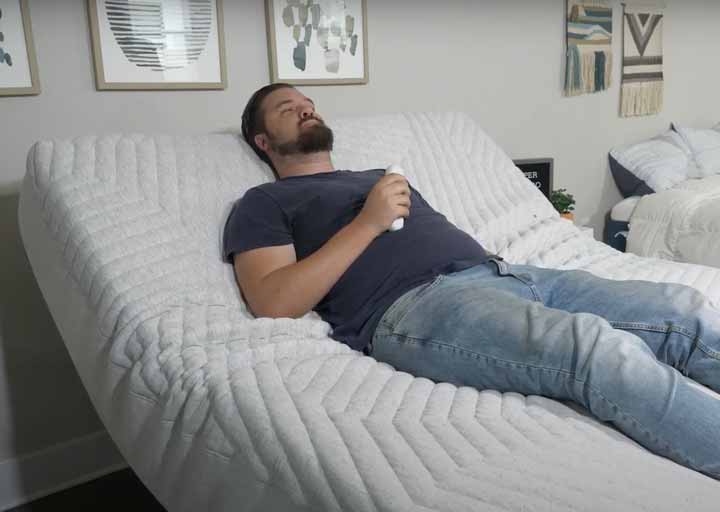
Adjustable bases and bed frames are an easy way to find that perfect elevation. Some might even have “anti-snore” settings preprogrammed into them. Not every mattress is designed to work with adjustable bases, so having beds that are either segmented on the bottom or are generally designed to work with adjustable bases is key.
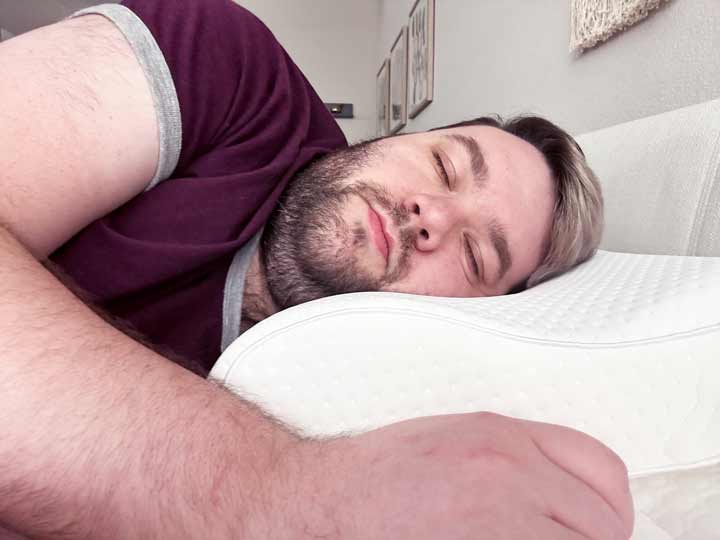
Pillows, too, can help with OSA to some degree. If the main goal is to open up your airways, having your head and neck in the proper position can help. We have a list of the best pillows for sleep apnea, and some of them look like normal pillows, but there are others like a wedge pillow or a pillow that can work with a CPAP machine that can do the trick.
Positional Therapy for Sleep Apnea FAQs
How long does it take for positional therapy for sleep apnea to work?
It depends. Training yourself to sleep on your side, for those who weren’t already side sleepers, can be a long process. It also depends on the severity of the OSA. Those with mild to moderate OSA may see results in as soon as a few weeks.
Do you need to complete a sleep apnea sleep study before trying positional therapy?
No, you don’t. Because positional therapy is just the act of changing your sleep position, it could just be a personal experiment for those who might want to try snoring less. However, if you do suspect you have any form of sleep apnea, it’s best to consult your doctor.
Can positional therapy cure sleep apnea?
No, but it can alleviate OSA symptoms. Back sleepers with OSA can find some relief with positional therapy, but there isn’t a cure for sleep apnea. The best way to go about handling OSA is with lifestyle or behavioral changes, like positional therapy, or using a CPAP machine.
Are positional therapy devices prescription only?
No. All the methods in this article can be practiced without the need for a prescription. However, I should note, consulting with your doctor on the best way to handle your OSA is crucial. Positional therapy works best for those with mild to moderate OSA. But if you have a CPAP machine and find that you can’t use it, positional therapy is often a second recommendation.


